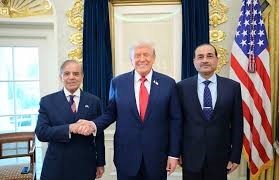On September 26, US President Donald Trump met with Pakistan Prime Minister Shehbaz Sharif and Field Marshal Asim Munir at the White House. This meeting marks a pivotal moment in US-Pakistan relations as leaders from both nations came together to discuss bilateral ties amidst the backdrop of the 80th United Nations General Assembly (UNGA).
The significant encounter occurred following Trump’s signing of several executive orders on the same day. While speaking to reporters, Trump referred to Sharif and Munir as “great leaders” and expressed optimism over their visit. He stated, “Field marshal is a very great guy, and so is the prime minister, both. And they’re coming.”
This visit is particularly noteworthy as it represents the first formal interaction between Trump and Sharif since the former’s presidency, contrasting with the previous meeting between Trump and former Pakistani Premier Imran Khan in July 2019.
Sharif was in the United States for the UNGA, where he is scheduled to address the General Debate. The meeting took place in the Oval Office and included key figures such as Vice President J.D. Vance and Secretary of State Marco Rubio.
The Pakistan Prime Minister’s Office (PMO) indicated that the meeting fostered a positive atmosphere, fostering discussion on matters vital to both nations. Initial reports suggested that the leaders addressed various issues of mutual interest, including regional stability and global security.
During the meeting, which began at approximately 4:30 PM local time, delays were noted due to Trump’s prior engagements. The discussion lasted around one hour and 20 minutes, with visual documentation showing an amicable exchange, including Trump’s familiar thumbs-up gesture in a group photo.
Sharif had previously engaged with Trump during an informal meeting in New York related to the UNGA session. That multilateral gathering included contributions from leaders of several nations, including Egypt, Indonesia, Qatar, Saudi Arabia, and Turkiye, among others.
Following their meeting, Trump reiterated his claims regarding international peace efforts, stating that he has “stopped seven wars.” He also mentioned that Pakistan nominated him for the 2026 Nobel Peace Prize, commending his diplomatic engagement during recent tensions between India and Pakistan. The President has made nearly 50 statements since May 10, declaring his role in mediating a ceasefire between the two nuclear-armed nations.
Nevertheless, India maintains that its agreement on hostilities arose following direct discussions between military commanders, significantly differing from Trump’s narrative.
The last Pakistani Prime Minister to visit the White House was Imran Khan, highlighting the importance of this recent meeting for both nations. Historically, the US and Pakistan have experienced a complex relationship, closely tied during the Cold War and the Afghan conflict, yet strained over issues like Afghanistan’s Taliban and counter-terrorism strategies.
The US trade agreement with Pakistan has undergone significant revisions, instituting a 19 percent tariff on Pakistani imports and facilitating US investment in Pakistan’s oil reserves. In 2024, US goods and services trade with Pakistan is estimated at USD 10.1 billion, reflecting a 6.3 percent increase from the prior year.
Trade statistics illustrate that US goods exports to Pakistan reached USD 2.1 billion in 2024, marking an increase of 3.3 percent from 2023, while imports climbed to USD 5.1 billion—a 4.8 percent rise. This culminated in a US trade deficit with Pakistan of USD 3 billion, increasing by 5.9 percent compared to the previous year.
As the two countries navigate their relationship, the implications of this meeting may resonate well beyond diplomatic courtesy, potentially steering the conversation surrounding cooperation on various regional and global platforms.




